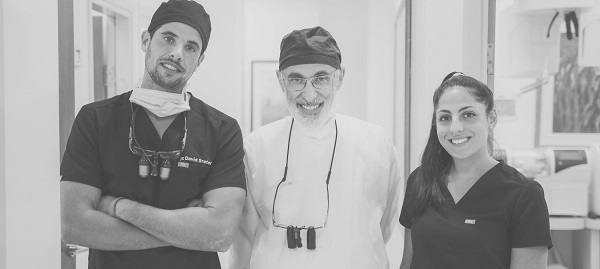
Getting More Information
Share This Page
1200 JADA, Vol. 140 http://jada.ada.org September 2009
FOR THE DENTAL PAT I E N T . . .
What it takes to be a dentist
Many people mistakenly believe that they should see a dentist only if they are in pain or feel that something is wrong.
They are unaware of the importance of maintaining good oral health or the fact that a dentist is a doctor who specializes in more than teeth and gums. He or she can recognize and diagnose a range of health conditions, some of which can be life threatening if left untreated.
The dental office is built on a team approach. It is designed to promote continuity of care that is comprehensive, convenient, cost-effective and efficient. Members of the team include office staff, dental assistants, hygienists and laboratory technicians. Leading the team is the dentist, who has earned a Doctor of Dental Medicine (DMD) degree or a Doctor of Dental Surgery (DDS) degree.
THE DENTIST'S ROLE
Dentists are doctors whose responsibilities include
In addition to treating teeth and gingivae (gums), dentists treat the muscles and nerves of the head, neck and jaws; the tongue; and the salivary glands.
During a comprehensive examination, they examine the teeth and gingivae, as well as look for abnormalities inside and outside the oral cavity, such as lumps, swellings, discolorations and ulcerations. When appropriate, dentists perform biopsies and diagnostic tests for infectious diseases and salivary gland function.
They also screen for oral cancer. Dentists can recognize early warning signs in the mouth that may indicate disease elsewhere in the body. Their training also enables them to recognize situations that warrant referral to dental specialists or physicians.
EDUCATION AND CLINICAL TRAINING
The level of education and clinical training required to earn a dental degree and the high academic standards of dental schools are on a par with those of medical schools. The traditional core curriculum during the first two years of dental and medical school is the same; students must complete courses in the biomedical sciences, such as anatomy and biochemistry.
During the second two years, dental students' course work focuses on diagnosing and treating oral diseases.
After earning their undergraduate and dental degrees (eight years for most people), many dentists continue their education and training in advanced general dentistry or in one of nine recognized dental specialties, which require between two and four or more years of specialized training.
To qualify for a license to practice, dentists must pass rigorous national written examinations and a state or regional clinical licensing examination. Some states allow for additional or alternative state-specific education or examinations for licensure. To maintain their licenses, dentists must meet continuing education requirements for the remainder of their careers. Doing so enables them to keep up-to-date with the latest scientific and clinical developments.
IMPROVING THE NATION'S ORAL HEALTH
An estimated 164 million work hours are lost each year because of oral disease. Much of this can be avoided if people receive routine preventive care.
The American Dental Association works to improve the nation's oral health through public education and legislative advocacy at federal and state levels. The ADA is working to improve America's oral health and give us all something to smile about.
To learn more about dentistry, visit “www.ada.org”.
Prepared by the American Dental Association Division of Government and Public Affairs. Copyright © 2009 American Dental Association. Unlike other portions of JADA, the print version of this page may be clipped and photocopied as a handout for patients without reprint permission from the ADA Publishing Division. Any other use, copying or distribution of this material, whether in printed or electronic form and including the copying and posting of this material on a Web site, is strictly prohibited without prior written consent of the ADA Publishing Division.
“For the Dental Patient” provides general information on dental treatments to dental patients. It is designed to prompt discussion between dentist and patient about treatment options and does not substitute for the dentist's professional assessment based on the individual patient's needs and desires.
Copyright © 2009 American Dental Association. All rights reserved. Reprinted by permission.
FOR THE DENTAL PAT I E N T . . .
What it takes to be a dentist
Many people mistakenly believe that they should see a dentist only if they are in pain or feel that something is wrong.
They are unaware of the importance of maintaining good oral health or the fact that a dentist is a doctor who specializes in more than teeth and gums. He or she can recognize and diagnose a range of health conditions, some of which can be life threatening if left untreated.
The dental office is built on a team approach. It is designed to promote continuity of care that is comprehensive, convenient, cost-effective and efficient. Members of the team include office staff, dental assistants, hygienists and laboratory technicians. Leading the team is the dentist, who has earned a Doctor of Dental Medicine (DMD) degree or a Doctor of Dental Surgery (DDS) degree.
THE DENTIST'S ROLE
Dentists are doctors whose responsibilities include
- performing comprehensive oral examinations;
- interpreting radiographs and the results of diagnostic tests;
- providing preventive care (such as prophylaxis [teeth cleaning], sealants [especially for children] and fluoride applications);
- diagnosing oral diseases;
- creating treatment plans to maintain or restore patients' oral health; dmonitoring the growth and development of teeth and jaws;
- performing surgical procedures in teeth, bone and soft tissues of the oral cavity;
- treating orofacial pain and oral trauma.
In addition to treating teeth and gingivae (gums), dentists treat the muscles and nerves of the head, neck and jaws; the tongue; and the salivary glands.
During a comprehensive examination, they examine the teeth and gingivae, as well as look for abnormalities inside and outside the oral cavity, such as lumps, swellings, discolorations and ulcerations. When appropriate, dentists perform biopsies and diagnostic tests for infectious diseases and salivary gland function.
They also screen for oral cancer. Dentists can recognize early warning signs in the mouth that may indicate disease elsewhere in the body. Their training also enables them to recognize situations that warrant referral to dental specialists or physicians.
EDUCATION AND CLINICAL TRAINING
The level of education and clinical training required to earn a dental degree and the high academic standards of dental schools are on a par with those of medical schools. The traditional core curriculum during the first two years of dental and medical school is the same; students must complete courses in the biomedical sciences, such as anatomy and biochemistry.
During the second two years, dental students' course work focuses on diagnosing and treating oral diseases.
After earning their undergraduate and dental degrees (eight years for most people), many dentists continue their education and training in advanced general dentistry or in one of nine recognized dental specialties, which require between two and four or more years of specialized training.
To qualify for a license to practice, dentists must pass rigorous national written examinations and a state or regional clinical licensing examination. Some states allow for additional or alternative state-specific education or examinations for licensure. To maintain their licenses, dentists must meet continuing education requirements for the remainder of their careers. Doing so enables them to keep up-to-date with the latest scientific and clinical developments.
IMPROVING THE NATION'S ORAL HEALTH
An estimated 164 million work hours are lost each year because of oral disease. Much of this can be avoided if people receive routine preventive care.
The American Dental Association works to improve the nation's oral health through public education and legislative advocacy at federal and state levels. The ADA is working to improve America's oral health and give us all something to smile about.
To learn more about dentistry, visit “www.ada.org”.
Prepared by the American Dental Association Division of Government and Public Affairs. Copyright © 2009 American Dental Association. Unlike other portions of JADA, the print version of this page may be clipped and photocopied as a handout for patients without reprint permission from the ADA Publishing Division. Any other use, copying or distribution of this material, whether in printed or electronic form and including the copying and posting of this material on a Web site, is strictly prohibited without prior written consent of the ADA Publishing Division.
“For the Dental Patient” provides general information on dental treatments to dental patients. It is designed to prompt discussion between dentist and patient about treatment options and does not substitute for the dentist's professional assessment based on the individual patient's needs and desires.
Copyright © 2009 American Dental Association. All rights reserved. Reprinted by permission.


